Hey there, fellow gardeners! Tired of those pesky mosquitoes turning your outdoor oasis into a no-go zone?
You’re not alone. Summer evenings should be about barbecues and fireflies, not itchy bites.
The good news? You can reclaim your yard with some easy, everyday tweaks. Let’s dive right into 15 simple ways to keep those bloodsuckers at bay and enjoy your space bug-free.
1. Dump Out Standing Water Everywhere

First things first: mosquitoes breed in standing water, so your top priority is to eliminate any spots where water collects.
Check your yard weekly for puddles in flowerpot saucers, birdbaths, kids’ toys, or even old tires. Empty them, scrub them clean to remove eggs, and flip them over if you can’t store them inside.
Got a rain barrel? Cover it tightly with mesh screening finer than a mosquito can squeeze through.
Why does this work? Female mosquitoes lay up to 300 eggs in just a teaspoon of water, and without it, they can’t multiply.
Quick tip 👉 After a rainstorm, do a quick sweep. It’s like hitting the reset button on your yard’s mosquito population.
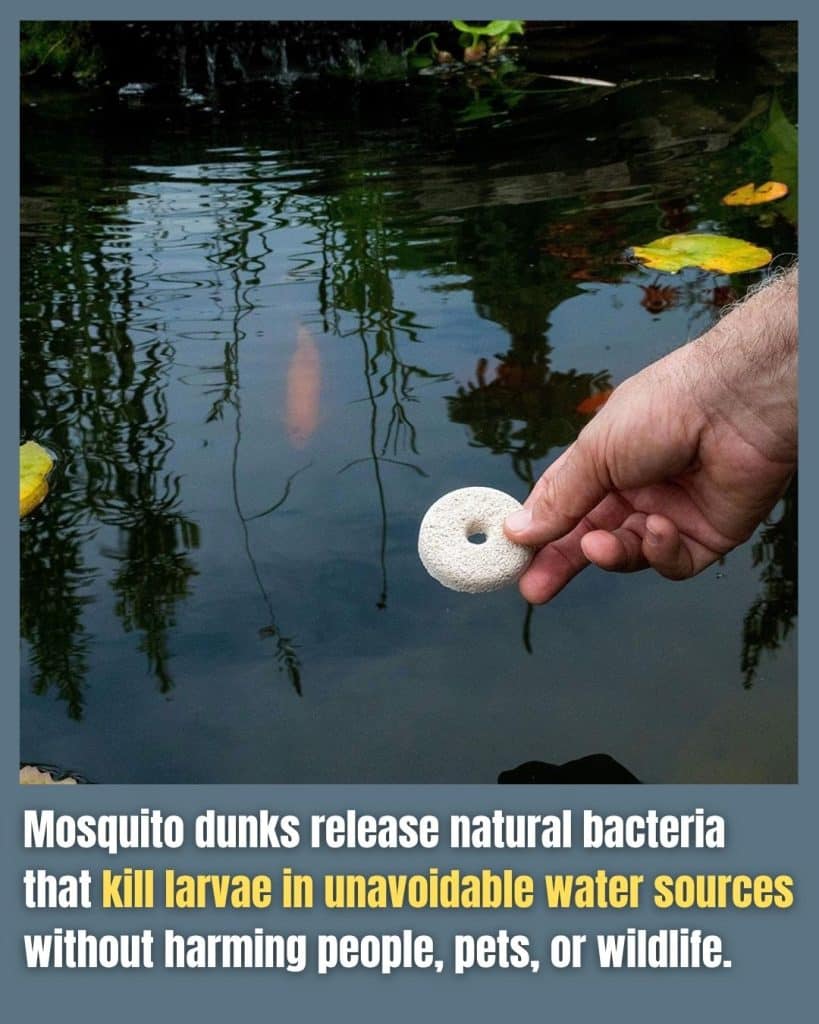
If you have features like ponds or fountains that you can’t drain, toss in some mosquito dunks.
These are little doughnut-shaped tablets made from Bacillus thuringiensis israelensis (BTI), a natural bacteria that’s harmless to people, pets, and wildlife but deadly to mosquito larvae.
Just drop one in per 100 square feet of water surface, and it’ll work for about 30 days. They’re super affordable and available at most garden stores.
This method targets the larvae before they become biting adults, cutting the cycle early.
Remember, refresh them monthly during mosquito season for ongoing protection, your fish and frogs won’t mind a bit.
3. Plant Mosquito-Repelling Herbs and Flowers

Turn your garden into a natural fortress by planting stuff mosquitoes hate.
Go for basil, lavender, lemongrass, catnip, marigolds, and citronella grass around patios, walkways, and seating areas.
These plants release scents that confuse or repel mosquitoes; citronella, for example, masks the carbon dioxide we exhale that attracts them.
Start with pots if you’re short on space; place them strategically near doors and windows. You’ll also get fresh herbs for cooking!
Water them regularly but avoid overwatering to prevent creating more breeding spots. In a few weeks, you’ll notice fewer buzzers, and your yard will smell amazing.
4. Keep Your Grass Short and Yard Tidy
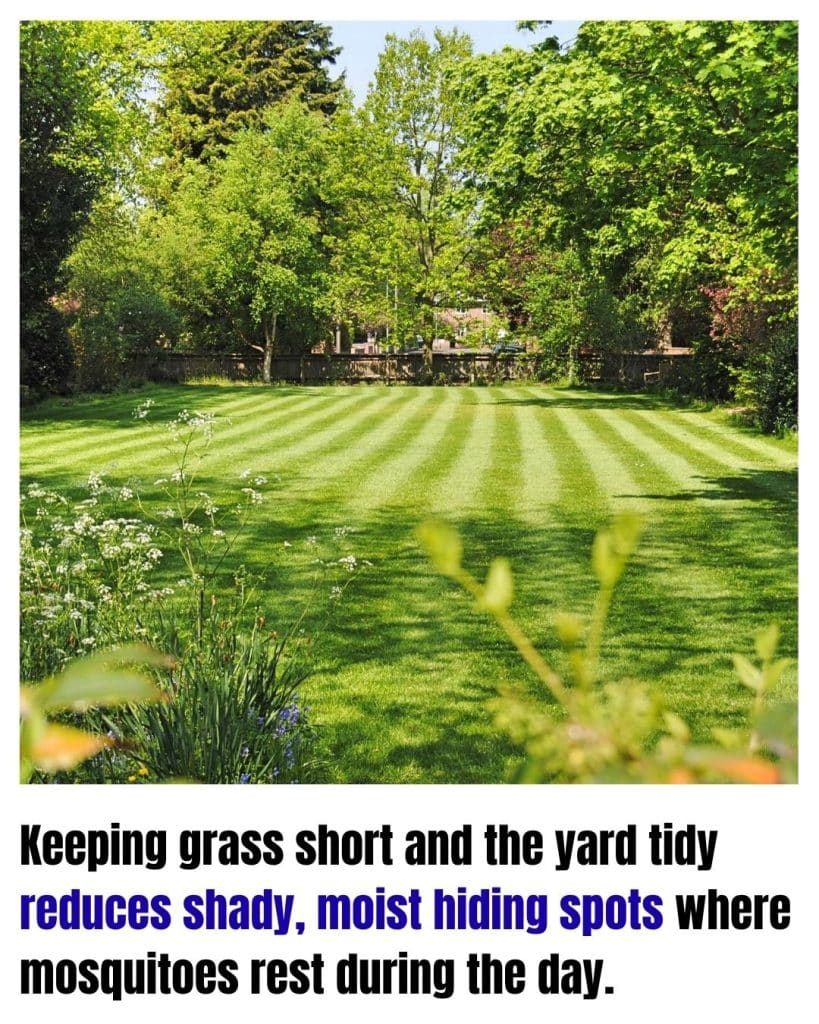
Mosquitoes love hiding in tall grass and overgrown bushes during the day, so mow your lawn every week to keep it under 3 inches high (be careful not to go lower during high summer).
Rake up leaves, trim shrubs, and clear debris piles. These shady, moist spots are prime resting areas. Dethatch your lawn if it’s thick with dead grass, as that holds moisture too.
This simple maintenance improves air flow and sunlight penetration, making your yard less inviting. It’s like giving mosquitoes an eviction notice.
Pair it with weeding to reduce vegetation where they perch. Your yard will look neater, and you’ll spend less time swatting.
5. Install Fans for a Breezy Barrier
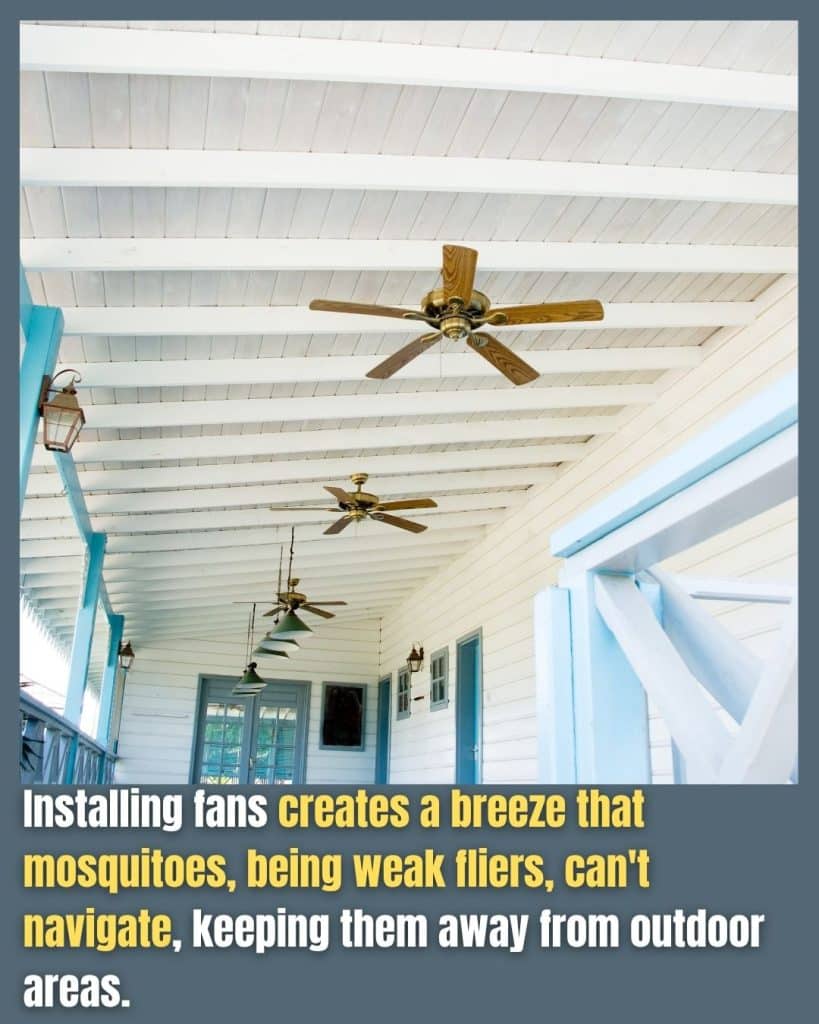
Mosquitoes are weak fliers, so a good breeze can blow them right off course.
Set up outdoor fans, box fans, oscillating ones, or even ceiling fans on patios to create constant airflow around gathering spots.
Aim for a wind speed of about 8-10 mph; that’s enough to keep them away without messing up your picnic.
Plug them in during evenings when mosquitoes are most active.
This is cheap, chemical-free, and doubles as cooling on hot days. Position fans low to the ground for best results, and watch your outdoor hangouts become bite-free zones.
6. Attract Natural Predators Like Birds and Bats
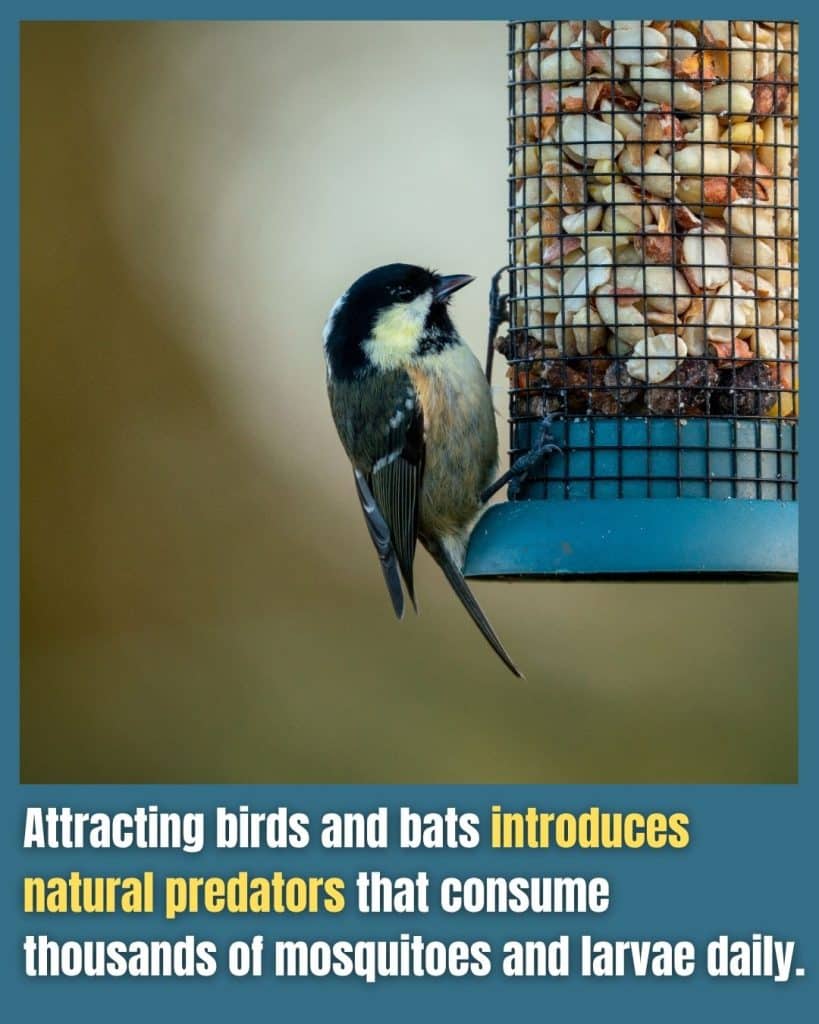
Invite mosquito-eating wildlife to do the work for you. Hang bird feeders or houses to draw in swallows, purple martins, or chickadees. They gobble up hundreds of insects daily.
For bats, install a bat box on a tree or pole at least 10-15 feet high; one bat can eat up to 1,000 mosquitoes a night!
Add a small pond with frogs or turtles if space allows, they love larvae snacks. Avoid pesticides that harm these helpers.
This eco-friendly approach builds a balanced yard ecosystem. Give it time (a few weeks) and you’ll see the mosquito numbers drop naturally.
7. Mulch with Cedar for a Scented Shield
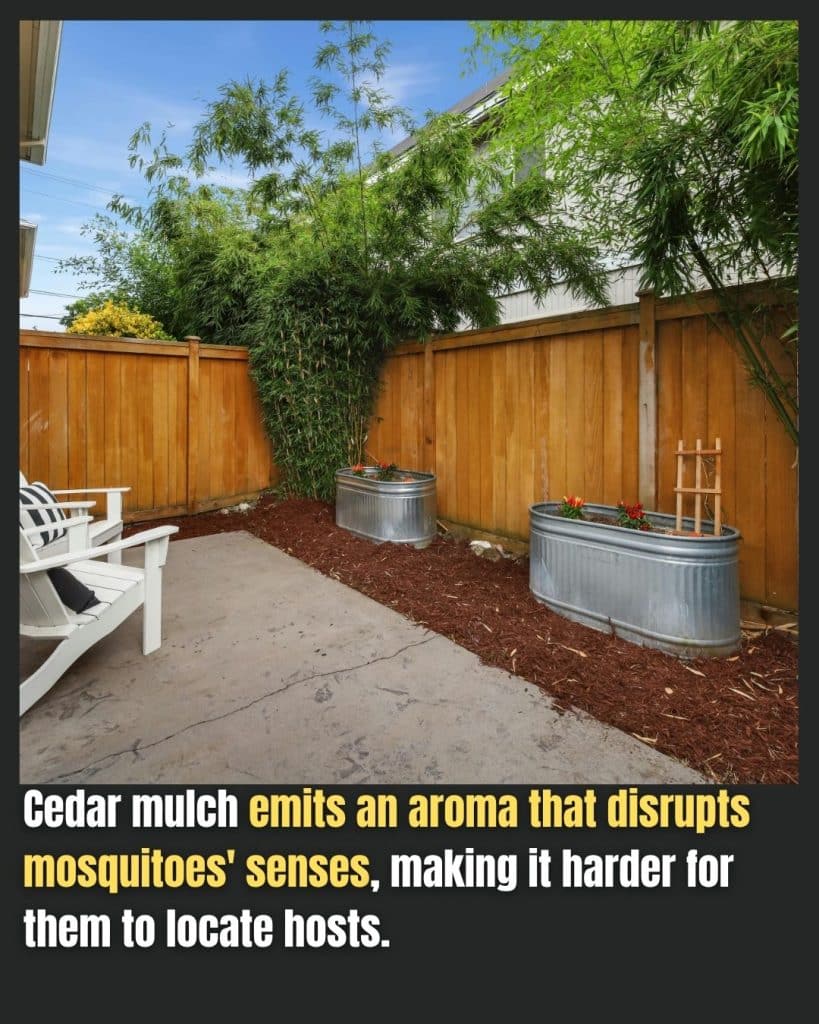
Switch to cedar mulch around plants and pathways; its strong aroma repels mosquitoes while smothering weeds and retaining soil moisture.
Spread a 2-3 inch layer, but keep it away from house foundations to avoid termites. Cedar oil disrupts mosquitoes’ senses, making it hard for them to find you.
Refresh it annually for lasting effect. It’s pet-safe and adds a nice rustic look to your landscaping.
Combine with repellent plants for double duty, your yard will be prettier and less itchy.
8. Scatter Coffee Grounds Around the Yard
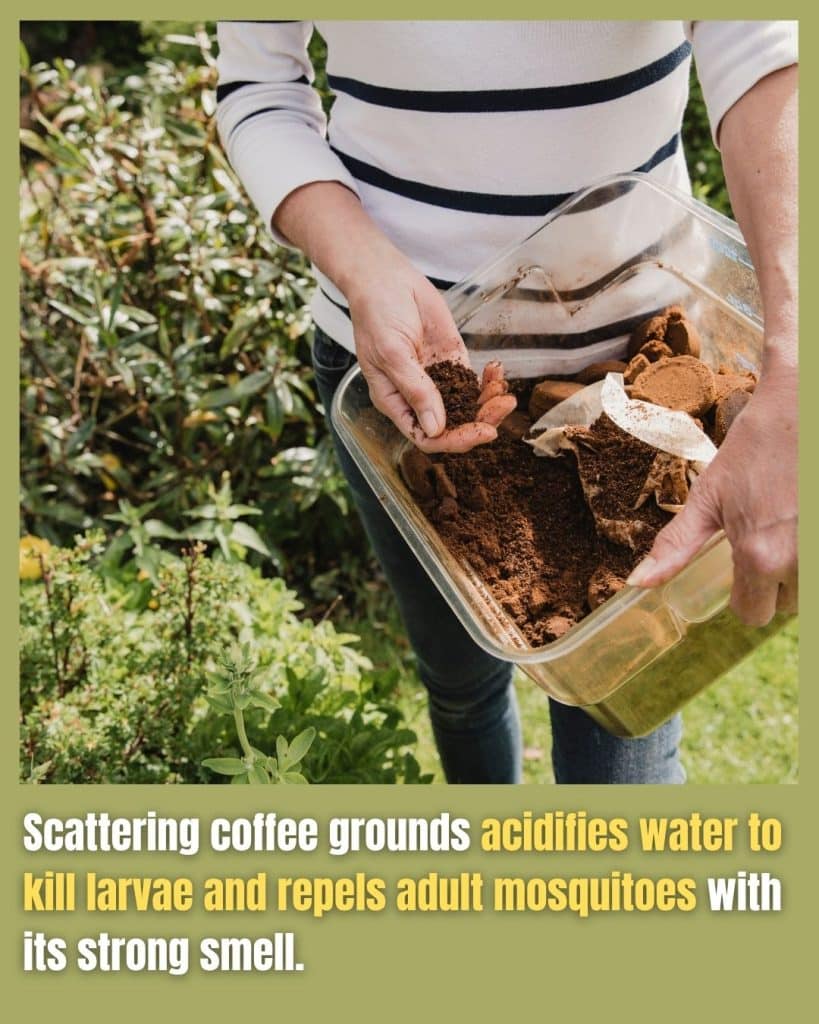
Used coffee grounds are a surprising mosquito hack. Sprinkle them in damp areas, garden beds, or standing water spots. They make the water too acidic for larvae to survive and repel adults with their smell.
Collect grounds from your morning brew, dry them out, and spread thinly to avoid mold. Repeat every few days, especially after rain.
This is free, eco-friendly, and also deters other pests like slugs. Your plants might even get a nitrogen boost. It’s a simple kitchen scrap trick that packs a punch.
9. Use Essential Oils in DIY Sprays
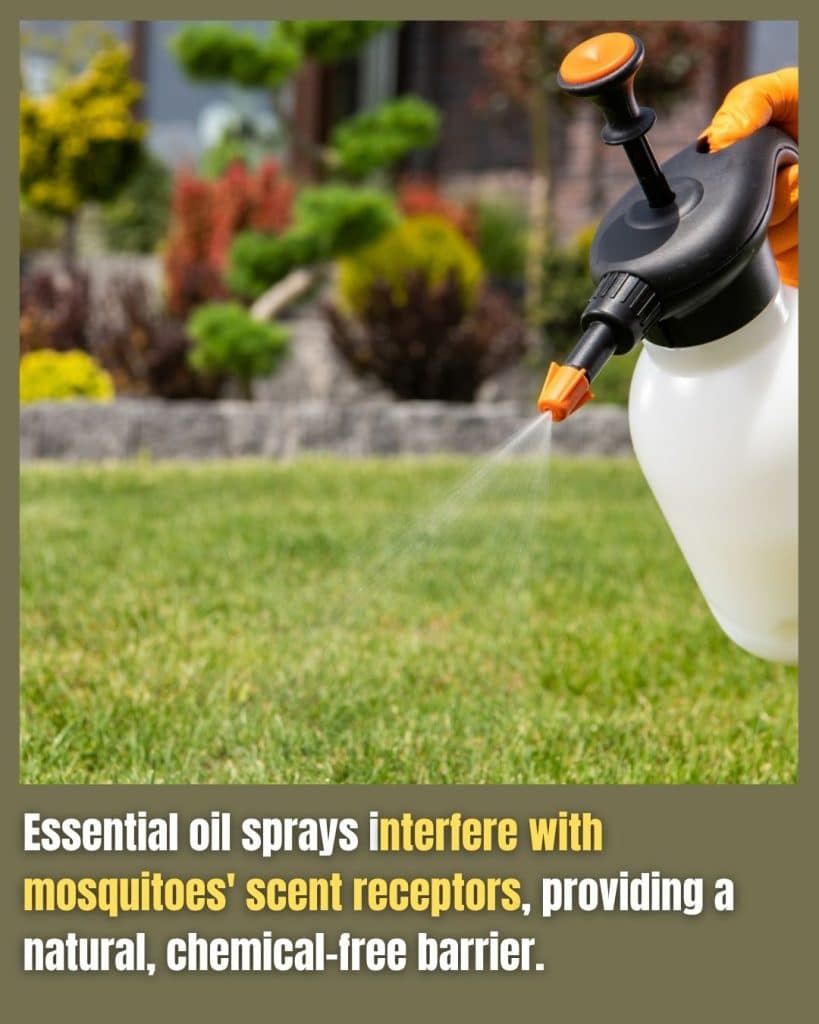
Whip up a natural repellent spray with essential oils like eucalyptus, lavender, peppermint, or tea tree.
Mix 20-25 drops with water and a splash of vodka in a spray bottle, then shake and spritz on plants, furniture, or even yourself.
These oils interfere with mosquitoes’ scent receptors.
Reapply every couple of hours or after rain. It’s safer than chemicals for kids and pets, and smells great.
Store in a cool place; experiment with blends for what works best in your area.
10. Set Up Mosquito Traps
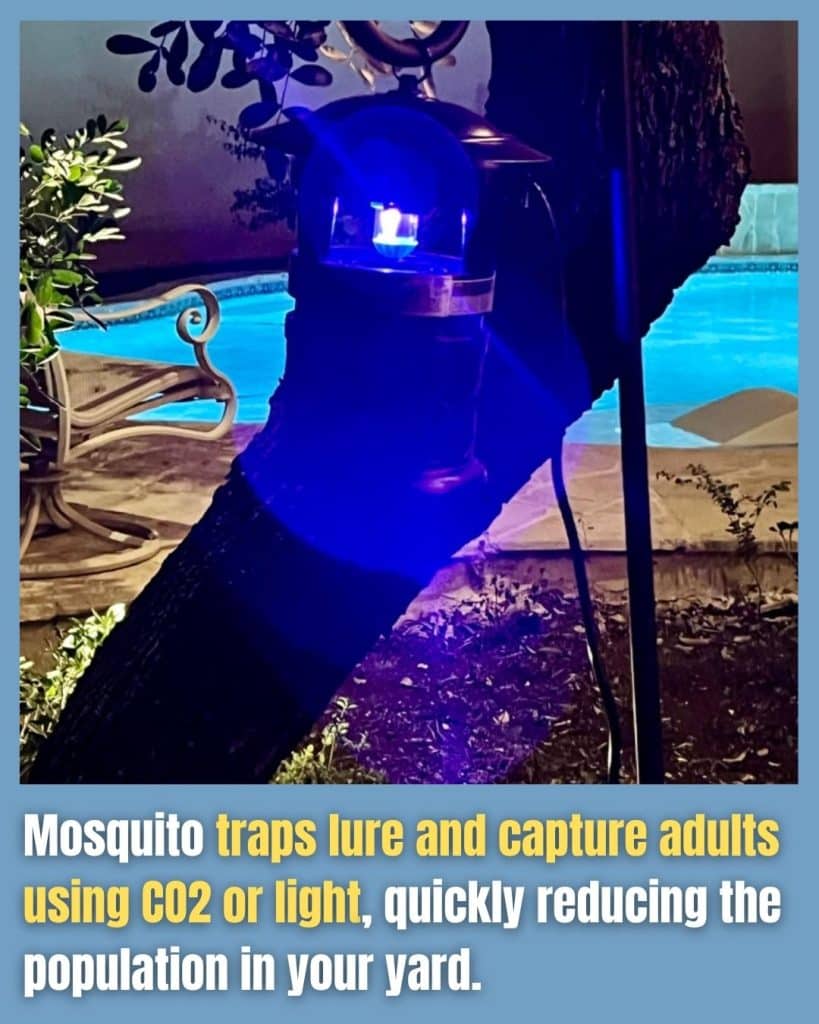
DIY or store-bought traps lure mosquitoes with CO2 or light and zap or trap them.
For a homemade version, cut a soda bottle, add yeast and sugar water to produce CO2, and invert the top as a funnel… They enter but can’t escape.
Place several around the yard’s edges. Commercial ones with fans suck them in. Check and empty weekly.
This reduces adult populations quickly, especially in small yards. Position away from people to draw them out.
11. Screen and Cover Everything Possible

Add fine mesh screens to windows, doors, and vents, Mosquitoes are tiny, so use 18×14 mesh or finer. Cover rain barrels, compost bins, and plumbing pipes.
For patios, consider screened enclosures or nets. This physical barrier keeps them out without chemicals. Inspect for tears regularly and repair with tape.
It’s a one-time setup that pays off all season, letting you enjoy fresh air bite-free.
12. Trim Dense Foliage and Remove Wind Blocks

Mosquitoes thrive in still, sheltered spots, so prune overgrown bushes and remove dense ivy or vines that block wind.
Open up areas for better circulation, think of it as aerating your yard.
Avoid tall fences or thick hedges if possible; opt for open designs. This exposes them to wind and predators. Do a seasonal trim in spring and fall.
Your yard will feel more spacious, and mosquitoes will have fewer hideouts.
13. Add Circulators to Water Features
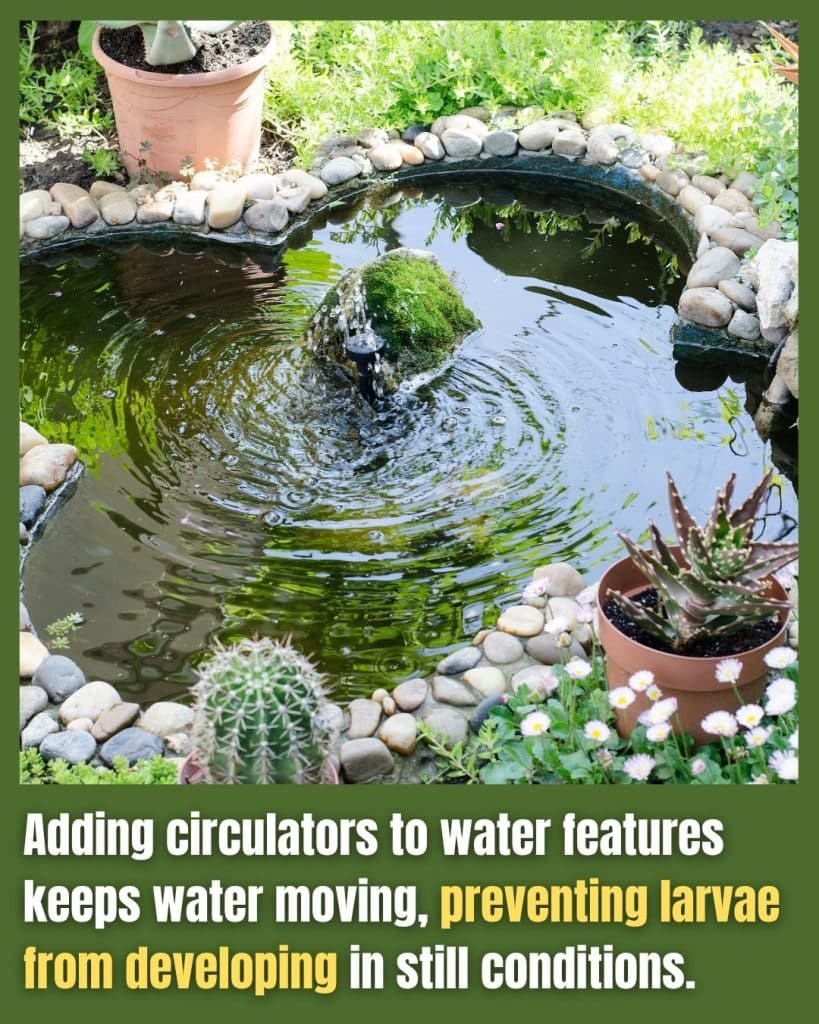
For ponds or fountains, install a pump or aerator to keep water moving. Mosquitoes need still water to breed.
A simple solar-powered fountain works great and adds ambiance. Change water weekly if small.
This prevents larvae from developing while keeping your feature pretty.
It’s low-maintenance and fish-friendly. Monitor for clogs to ensure constant flow.
14. Encourage Dragonflies and Other Insects
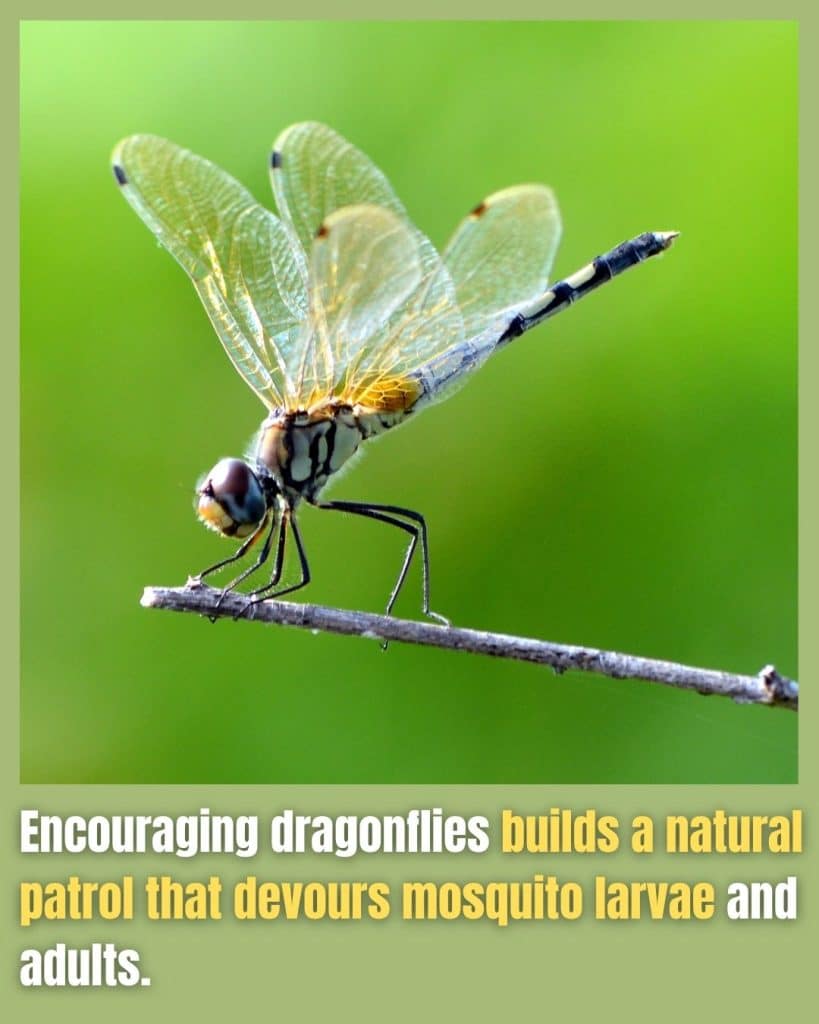
Dragonflies are mosquito assassins, eating larvae and adults. Create habitat with a shallow pond or wetland area stocked with native plants.
Avoid broad pesticides. Add perches like tall grasses. In time, they’ll patrol your yard naturally.
This boosts biodiversity and is fascinating to watch, turn your yard into a mini nature reserve.
15. Switch to Yellow LED Lights Outdoors
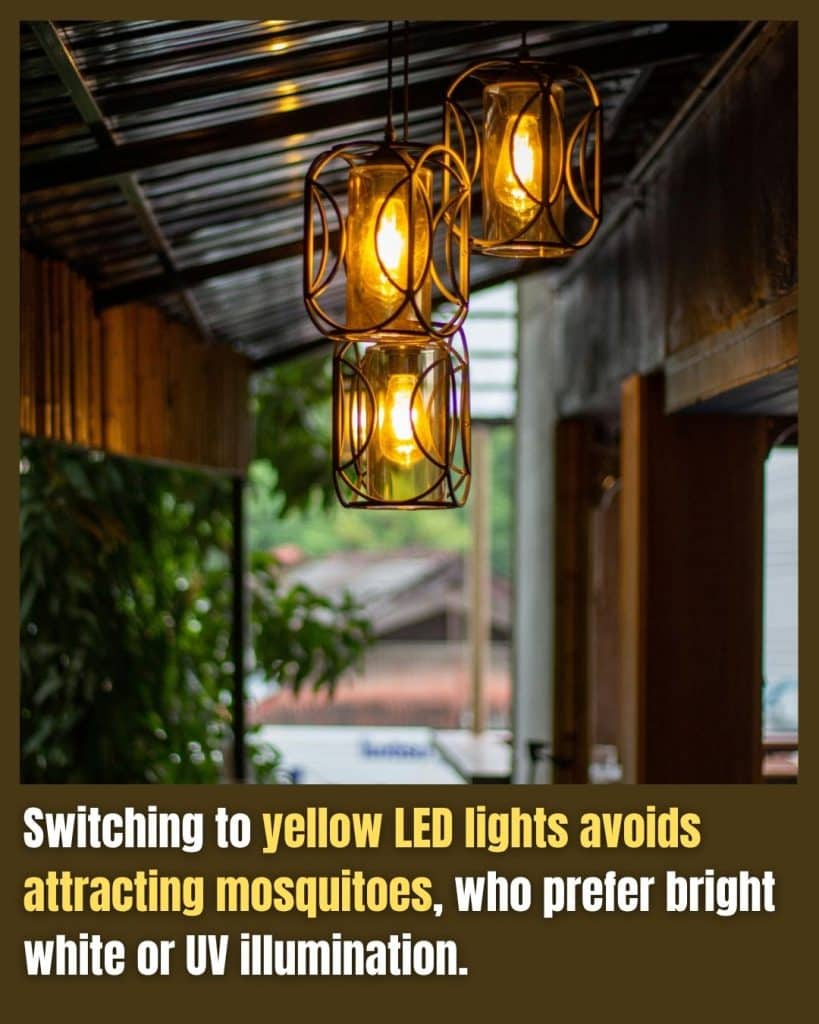
Mosquitoes are drawn to bright white or UV lights, so swap to yellow or warm LED bulbs for porches and paths. They’re less attractive and energy-efficient.
Use motion sensors to minimize light time. This simple change cuts down on nighttime swarms without affecting your visibility.
It’s an easy, low-cost upgrade that makes evenings more pleasant.
Mosquito Deterrent Best Practices

Now that you’ve got those 15 ways locked in, let’s talk about tying it all together with some best practices to make your mosquito-proofing efforts stick.
Think of this as the maintenance manual for a bug-free yard, because consistency is key to keeping those suckers away for good.
Start with timing:

Mosquito season ramps up in spring, so kick off your prevention in early April or whenever temps hit 50°F consistently. That’s when females start laying eggs.
Do a full yard audit then, walk around with a checklist for standing water, overgrown spots, and potential breeding sites.
Repeat this monthly through fall to catch any slip-ups. Early action prevents populations from exploding; waiting until bites start means you’re playing catch-up.
Layer your defenses for maximum impact.

Don’t just pick one method; combine them. For example, eliminate water sources while planting repellents and using fans.
This multi-prong approach hits mosquitoes at every life stage, eggs, larvae, pupae, and adults.
methods like plants and predators are great for ongoing control, but if you’re dealing with a heavy infestation, layer in dunks or traps for a quick knockdown.
Always prioritize eco-friendly options to protect bees, butterflies, and other beneficial bugs. Your yard’s ecosystem will thank you.
Maintenance is non-negotiable.
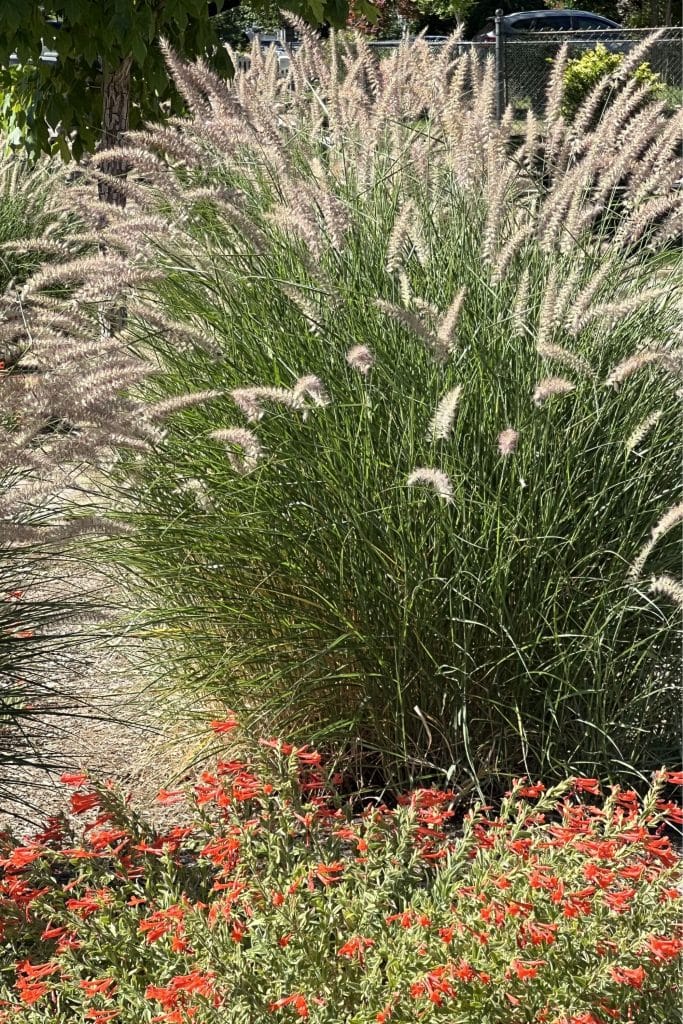
Check dunks and traps weekly, refresh mulch and coffee grounds after rain, and prune vegetation as it grows.
For sprays and oils, reapply every 2-3 hours during peak times (dawn and dusk, when mosquitoes are hungriest).
Keep an eye on the weather. Heavy rains can create new puddles, so patrol post-storm. If you have kids or pets, stick to non-toxic stuff like BTI or essential oils, and test small areas first for allergies.
Don’t Skip Out on The Active Protection

Personal protection ties in too. Even with a fortified yard, wear long sleeves, use DEET-free repellents on skin, and avoid sweet scents that attract them (skip the fruity lotions).
For parties, light citronella candles 30 minutes early to build a scent barrier. If you’re in a high-risk area for diseases like West Nile, consult local health departments for alerts and consider professional spraying as a last resort, they use targeted treatments that minimize harm.
Track your progress:
Keep a simple journal of mosquito sightings or bites. If numbers drop, pat yourself on the back; if not, tweak your strategy, maybe add more fans or predators. Community helps too, chat with neighbors about shared efforts, like draining communal ditches, to create a block-wide shield.
Finally, remember that patience pays off. It might take a couple of weeks to see big changes, but sticking with these practices turns your yard into a no-fly zone.
You’ll save on itch creams, enjoy more outdoor time, and even boost your property’s appeal. Stay vigilant, stay bite-free, and here’s to mosquito-less summers ahead!